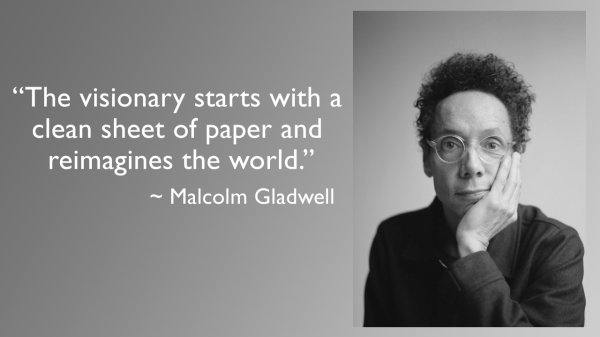
Did you know there is a big difference between having a strong passion and having an unwavering vision? The main difference is that passion is the thing that excites and inspires you, while vision often requires something unique only to you that sparks your drive and determination.
And, in some cases, passion can wane or falter depending on one’s mood or state of mind, whereas vision always stays strong.
Another distinction between the two is that passion is an immediate state of feeling or emotion, and vision is about creating future events.
Having a strong vision means seeing an opportunity of something yet to come. Being a Visionary means seeing a future of your own creation and design.

Passion, of course, can help to get you there. Passion, inspiration, enthusiasm, and excitement are all emotive drivers to keep you energized. Your feelings can propel you forward, but feelings can also stall your progress.
Passion comes from emotion. Passion makes a pursuit more thrilling and alive. And who doesn’t want a life full of passion? When you’re passionate, things are more connected, exciting, vibrant, and flow your way.
However, humans are emotion-based creatures, and when an emotional reaction interrupts our passionate state, such as sadness, anger, loss, upset, or disappointment, we get derailed, and it becomes harder to get our motivation and energy back on track.
But a vision is something that stays with you to the end. It’s a driving force to discover, figure something out, and unravel a thread of curiosity to see where it leads.
A true Visionary reimagines the world.
Vision evolves when someone has cultivated their artistic, creative, or intuitive nature. It thrives when one is allowed to daydream and fantasize, to imagine greater.
In other words, vision is divergent. Divergent thinking allows one to imagine many possibilities and outcomes. It permits one’s imagination to go beyond the limitations of pragmatic or practical ideas.
When handheld cellular phones first came out, we were only able to see them in a limited, one-dimensional way. And people kept innovating to improve upon their standard concepts. This is referred to as convergent thinking, attempting to get the best iteration of what currently exists. That is what innovation is all about.
Yet the iPhone changed all that. It didn’t look at the current conventional device and simply improve on its concept. Instead, it took a completely radical shift and thought about the experience rather than the functionality first. And now everyone is following this visionary lead.
To create bolder, you must be willing to play bigger, play by your own rules, and accept that you may be challenged at every turn by those who don’t and may never understand or see your unique vision.
To be a true visionary is to be able to see how things should be rather than how they are.
A true visionary doesn’t know if their idea will lead anywhere. They just need to see their vision (future concept) through to the very end, until they either run out of steam or can’t go any further.
A visionary idea is something that has otherwise not yet been proven to have merit or social acceptance. Turing created his computer. Noyce developed the microchip. Tesla imagined the future of AC electricity. Faraday envisioned electromagnetism. Parsons built rockets. All things that at the time were just fantasy. Their unique vision changed both the reality of their worlds—and ours.
It all starts with an idea or question. When a Visionary becomes intrigued with an idea, they become relentlessly obsessive. When they’re captivated by something new or unusual, they’re filled with wonder.
Highly visionary people don’t start with the idea of wanting to create a successful business. They start with an imaginative idea and only from their unwavering pursuit did some of these ideas later grow into viable businesses that people stand in line just to get hired at: Disney, Facebook, Apple, Oracle, Marvel, Microsoft, Pixar, Amazon. These inceptions all came from someone’s unique vision and imagination, and only then did they become highly successful businesses.
Some examples of natural Visionaries are painters, designers, artists, comedians, authors, cartoonists, and architects. These are all people who think creatively, not limiting how they see the world, always putting their unique spin on it and seeing how it could be, not how it is.
It should be noted that initially, others will doubt your vision as silly, whimsical, or ungrounded. They will challenge you at every turn, simply because they cannot see what you see or how you see it.
Stay the course. A true Visionary creates doorways where once there were none. You must trust in yourself even when things get challenging.

How Does One Cultivate Seeing Differently?
Simple:
- Wonder— If something gnaws at you, calls to you, makes you deeply curious, tug at that thread.
- Curiosity— If you think about it a lot, want to know more, then pursue it.
- Exploration— If it fascinates you, titillates you, intrigues you, makes you silly with unanswered questions, pursue it and unravel that thread.
You don’t need tools, tricks, or techniques to bring this about. All you need is to explore, investigate, and be open to what you discover.
Your vision may not lead anywhere initially, but as you get better at this it can become the catalyst for future discovery. It may take a while to piece together all the bits of information and awareness you’ve gathered into a tapestry of something wonderful.
Always strive to see beyond what you currently see.
Cultivating Your Own Visionary Style:
- Be a provocateur
- Question things
- Don’t draw conclusions
- Be open to the adventure of discovery
- Be fearless
- Start small
- Show, don’t tell
- Persist
- Don’t listen to conventional wisdom
- Don’t focus on the results. Instead, keep your eyes on your concept and let it lead you
How can you develop your own unique vision?
- See things like an artist— Life is a blank canvas or lump of clay
- Inception (the movie)— Don’t be afraid to bend something that doesn’t bend. Turn and fold the impossible. (Study works by Salvador Dali or M.C. Escher)
- See things as if through a kaleidoscope— Be playful, yet nonconformist, in your observations
- Distort reality— Switch the logical order of things.
- Perspective – Look behind you…literally – Get in the habit of seeing where you were by looking from the reverse perspective, which changes how you look at it. There is an art form called 3D Sidewalk Art, whose perspective changes when you walk from one side to the other because the shape and depth of the piece allows for two different sensory observations.
- Seek out the adventure—What do you see as adventure, where others only see ordinary? Adults see a backyard as ordinary, while children see it as a world of fantasy and imagination.
When we learn to see with vision, we create endless possibilities—travel to Mars, extended life, develop nanotechnology, 3D printing, robotic applications, AI, and wireless communications for instant connection with people on the opposite side of the world. Once we reached for the stars, now we reach beyond. Our limits are only what we “choose” not to see.
Learning to become a visionary expands your scope to see the world differently and therefore see your place in it. When you learn to bend the world with your ideas, your perspective changes, no longer hindered by rules and limiting conditions.
Learn to free yourself by mastering your visionary style. It will take some practice, initially, but one tip is to forgo logic and practical application. Learn to let go of rigid concepts. Imagination can take you anywhere you dream. Having a unique vision can take you everywhere you desire.